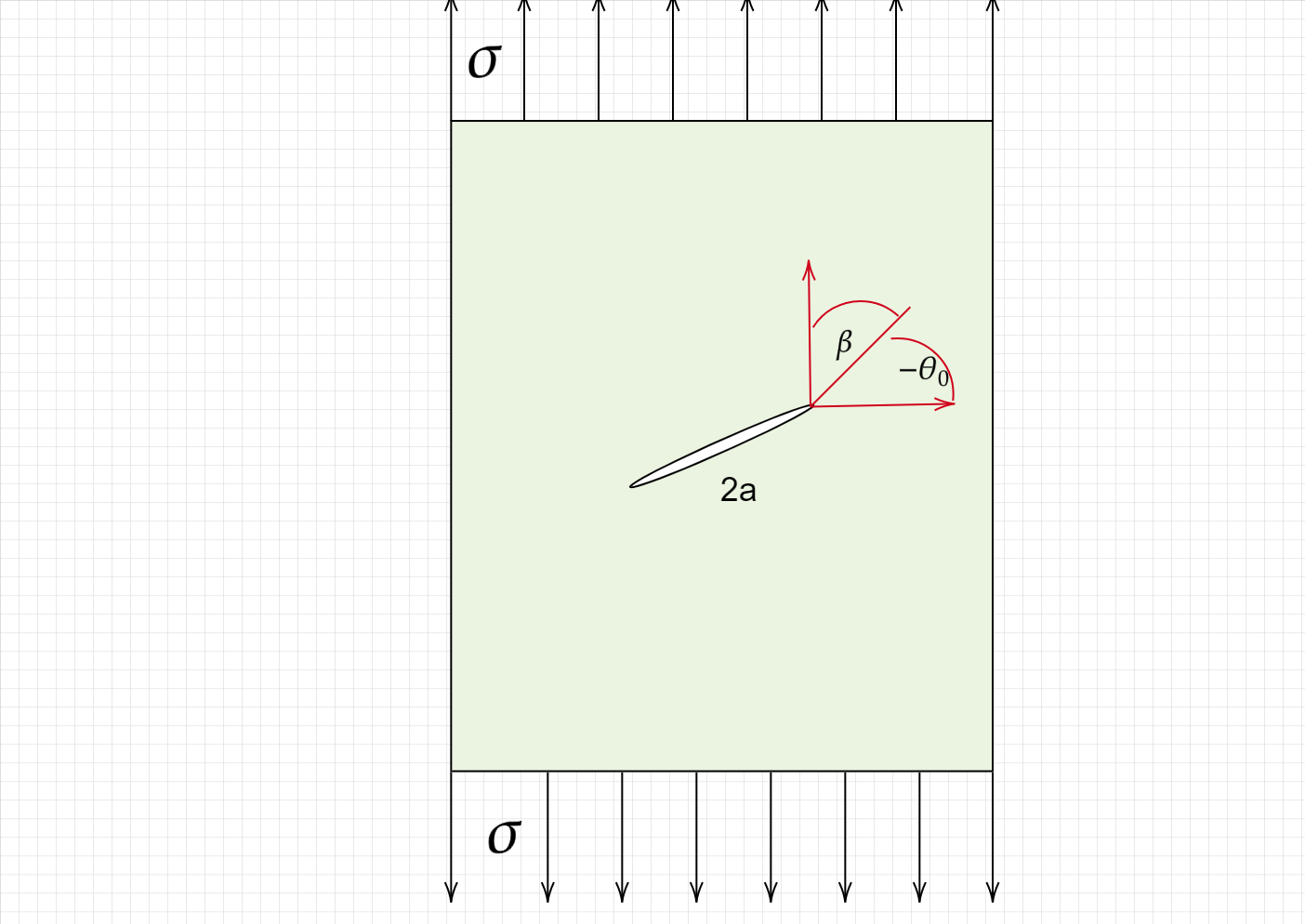Mixed Mode Fracture#
Motivation
So far we have discussed mostly mode I cracks (tensile) however real life scenarios will often involve not only tensile tractions ths leading to mixed mode interactions
Mixed-mode scenarios will often be found in heterogenous structures (multi-phase materials, weldements, coatings, composites etc.).

We can use superposition and obtain the crack tip fields as
And the displacements:
Energy release rate#
We can write the total energy release write to be
Assuming we already measured the critical value of \(G_I=G_{IC}=\frac{K_{IC}^2}{E'}\)
We can see that for mixed mode loading we obtain
Question
What is the meaning of the expression we just obtained?
For the 2D problem sketched above we can write the stresses as
leading to
and then
Example
Consider a plate with a \(10mm\) crack at angle \(\beta\) subjected to an applied stress of \(130 MPa\). Assuming that the \(K_{IC}\) is known and equal \(25 MPa\sqrt{m}\) find out if the plate will fail for any value of \(\beta\)
Using the above equations we can find the values of \(K_I\) and \(K_{II}\) as a function of the angle to be
and then
This expression will always yield a result smaller than \(25MPa\sqrt{m}\)
Under mixed mode conditions, cracks may propagate at an inclined angle (\(\theta_c\)) to their original direction (\(\beta\))
Writing \(\theta_c=\frac{\pi}{2}-\beta\) and using the \(K_{IC}\) expression we obtain
I the crack will grow aligned with the \(x\) direction, this will lead to \(K=K_I\) and \(K_{II} \to 0\).
For some materials, it was observed that the relation
is a better approximation to the mixed-mode conditions leading to
Which leads to
Principle stress#
The principle stress criterion requires that the crack will grow in the direction perpendicular to the maximum principal stress.
Considering the same 2D problem as before, and setting \(\tau_{r \theta}=0\) (so that \(\sigma_{\theta \theta}\) will become a principal stress) we can rewrite the expressions for the stress intensity factors :
we define \(K_r = \frac{K_I}{K_{II}}\) to obtain
This gives us a way of finding the crack growth direction if we know \(K_r\)
For a pure mode II loading we will obtain \(\theta_c = -70.53^o\)
The maximum principle stress can be derived to be (some trgo which we skip) :
and using the definition of \(K_{IC}\) for a pure mode I we obtain
Looking at the angle for a pure mode II (\(\theta_c = -70.53\)) we can see that under this criterion
Strain energy density criterion#
Sih proposed that the strain energy density \(S\) dictates the crack growth direction such that crack growth will start in the direction for which :
To use this criterion we thus have to define \(W_c\) at \(\theta=\theta_c\).
The strain energy can be derived using the stress fields and the definition of work done on a body to obtain
Excersice
Consider the same plate as before being subjected to a mixed mode loading under plane strain conditions. We are given with the following inputs:
The plate fractures if \(\sigma_{yy} = 150MPa\) or \(\tau_{xy}=90MPa\)
The crack length is \(a=30 mm\)
\(\nu = 0.33\) and \(E=\195GPa\)
Use the strain energy density criteria to calculate:
\(\theta_c\)
\(\beta\)
\(K_IC\) and \(K_{IIC}\)
Compare the results to what you would have obtained using the maximum principle stress criterion.
Guidance principla stress
Find the stress intensity factors.
Find \(K_r\)
Use the equation we derived for \(\theta_c\) based on \(K_r\)
FInd \(\beta\)
Calculate \(K_{IC}\) and \(K_{IIC}\)
strain energy density
calculate \(\kappa\)
use the relation between \(S\) and the stress intensity factors to find \(\theta_c\) by taking the derivative with respect to \(\theta\) as \(0\) and setting \(\theta= \theta_c\) 3.Calculate \(K_{IC}\) and \(K_{IIC}\)
Find \(S_C\)
